ShakeDrop Regularization: Difference between revisions
| Line 112: | Line 112: | ||
The novelty of this paper is low as pointed out by the reviewers. The proposed ShakeDrop regularization is essentially a combination of the PyramidDrop and Shake-Shake regularization. The most surprising part is that the forward weight can be negative thus inverting the output of a convolution. The mathematical justification for ShakeDrop regularization is limited, relying on intuition and empirical evidence instead. | The novelty of this paper is low as pointed out by the reviewers. The proposed ShakeDrop regularization is essentially a combination of the PyramidDrop and Shake-Shake regularization. The most surprising part is that the forward weight can be negative thus inverting the output of a convolution. The mathematical justification for ShakeDrop regularization is limited, relying on intuition and empirical evidence instead. | ||
As pointed out from the above, the method basically relies heavily on the intuition. This means that the performance of the algorithm can vary a lot depending on the characteristics of data sets that users are performing. | As pointed out from the above, the method basically relies heavily on the intuition. This means that the performance of the algorithm can vary a lot depending on the characteristics of data sets that users are performing, with some exaggeration. However, the performance is still impressive since it performs better than known algorithms. | ||
=References= | =References= | ||
Revision as of 09:38, 29 November 2018
Introduction
Current state of the art techniques for object classification are deep neural networks based on the residual block, first published by (He et al., 2016). This technique has been the foundation of several improved networks, including Wide ResNet (Zagoruyko & Komodakis, 2016), PyramdNet (Han et al., 2017) and ResNeXt (Xie et al., 2017). They have been further improved by regularization, such as Stochastic Depth (ResDrop) (Huang et al., 2016) and Shake-Shake (Gastaldi, 2017), which can avoid some problem like vanishing gradients. Shake-Shake applied to ResNeXt has achieved one of the lowest error rates on the CIFAR-10 and CIFAR-100 datasets. However, it is only applicable to multi-branch architectures and is not memory efficient since it requires two branches of residual blocks to apply. To address this problem, ShakeDrop regularization that can realize a similar disturbance to Shake-Shake on a single residual block is proposed. Moreover, they use ResDrop to stabilize the learning process. This paper seeks to formulate a general expansion of Shake-Shake that can be applied to any residual block based network.
Existing Methods
Deep Approaches
ResNet, was the first use of residual blocks, a foundational feature in many modern state of the art convolution neural networks. They can be formulated as [math]\displaystyle{ G(x) = x + F(x) }[/math] where [math]\displaystyle{ x }[/math] and [math]\displaystyle{ G(x) }[/math] are the input and output of the residual block, and [math]\displaystyle{ F(x) }[/math] is the output of the residual branch on the residual block. A residual block typically performs a convolution operation and then passes the result plus its input onto the next block.
Intuition behind Residual blocks: If the identity mapping is optimal, We can easily push the residuals to zero (F(x) = 0) than to fit an identity mapping (x, input=output) by a stack of non-linear layers. In simple language it is very easy to come up with a solution like F(x) =0 rather than F(x)=x using stack of non-linear cnn layers as function (Think about it). So, this function F(x) is what the authors called Residual function (Reference).
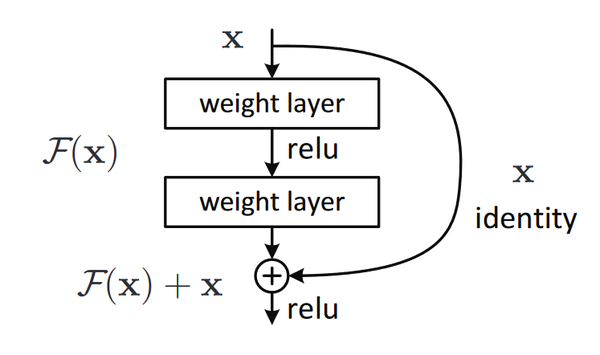
ResNet is constructed out of a large number of these residual blocks sequentially stacked. It is interesting to note that having too many layers can cause overfitting, as pointed out by He et al. (2016) with the high error rates for the 1,202-layer ResNet on CIFAR datasets. Another paper (Veit et al., 2016) empirically showed that the cause of the high error rates can be mostly attributed to specific residual blocks whose channels increase greatly.
PyramidNet is an important iteration that built on ResNet and WideResNet by gradually increasing channels on each residual block. The residual block is similar to those used in ResNet. It has been used to generate some of the first successful convolution neural networks with very large depth, at 272 layers. Amongst unmodified residual network architectures, it performs the best on the CIFAR datasets.

Non-Deep Approaches
Wide ResNet modified ResNet by increasing channels in each layer, having a wider and shallower structure. Similarly to PyramidNet, this architecture avoids some of the pitfalls in the original formulation of ResNet.
ResNeXt achieved performance beyond that of Wide ResNet with only a small increase in the number of parameters. It can be formulated as [math]\displaystyle{ G(x) = x + F_1(x)+F_2(x) }[/math]. In this case, [math]\displaystyle{ F_1(x) }[/math] and [math]\displaystyle{ F_2(x) }[/math] are the outputs of two paired convolution operations in a single residual block. The number of branches is not limited to 2, and will control the result of this network.
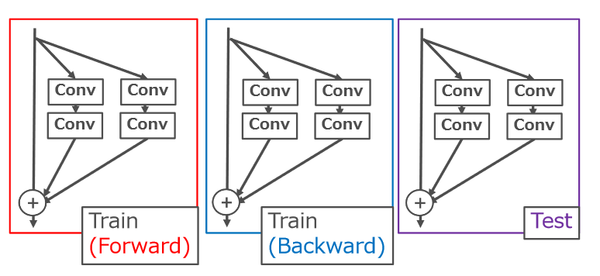
Regularization Methods
Stochastic Depth helped address the issue of vanishing gradients in ResNet. It works by randomly dropping residual blocks. On the [math]\displaystyle{ l^{th} }[/math] residual block the Stochastic Depth process is given as [math]\displaystyle{ G(x)=x+b_lF(x) }[/math] where [math]\displaystyle{ b_l \in \{0,1\} }[/math] is a Bernoulli random variable with probability [math]\displaystyle{ p_l }[/math]. Using a constant value for [math]\displaystyle{ p_l }[/math] didn't work well, so instead a linear decay rule [math]\displaystyle{ p_l = 1 - \frac{l}{L}(1-p_L) }[/math] was used. In this equation, [math]\displaystyle{ L }[/math] is the number of layers, and [math]\displaystyle{ p_L }[/math] is the initial parameter.
Shake-Shake is a regularization method that specifically improves the ResNeXt architecture. It can be given as [math]\displaystyle{ G(x)=x+\alpha F_1(x)+(1-\alpha)F_2(x) }[/math], where [math]\displaystyle{ \alpha \in [0,1] }[/math] is a random coefficient. [math]\displaystyle{ \alpha }[/math] is used during the forward pass, and another identically distributed random parameter [math]\displaystyle{ \beta }[/math] is used in the backward pass. This caused one of the two paired convolution operations to be dropped, and further improved ResNeXt.
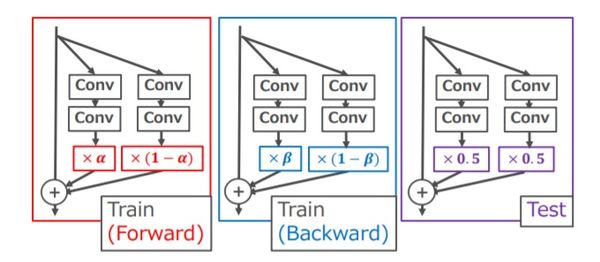
Proposed Method
This paper seeks to generalize the method proposed in Shake-Shake to be applied to any residual structure network. Shake-Shake. The initial formulation of 1-branch shake is [math]\displaystyle{ G(x) = x + \alpha F(x) }[/math]. In this case, [math]\displaystyle{ \alpha }[/math] is a coefficient that disturbs the forward pass, but is not necessarily constrained to be [0,1]. Another corresponding coefficient [math]\displaystyle{ \beta }[/math] is used in the backwards pass. Applying this simple adaptation of Shake-Shake on a 110-layer version of PyramidNet with [math]\displaystyle{ \alpha \in [0,1] }[/math] and [math]\displaystyle{ \beta \in [0,1] }[/math] performs abysmally, with an error rate of 77.99%.
This failure is a result of the setup causing too much perturbation. A trick is needed to promote learning with large perturbations, to preserve the regularization effect. The idea of the authors is to borrow from ResDrop and combine that with Shake-Shake. This works by randomly deciding whether to apply 1-branch shake. This creates in effect two networks, the original network without a regularization component, and a regularized network. When mixing up two networks, we expected the following effects: When the non regularized network is selected, learning is promoted; when the perturbed network is selected, learning is disturbed. Achieving good performance requires a balance between the two.
ShakeDrop is given as
[math]\displaystyle{ G(x) = x + (b_l + \alpha - b_l \alpha)F(x) }[/math],
where [math]\displaystyle{ b_l }[/math] is a Bernoulli random variable following the linear decay rule used in Stochastic Depth. An alternative presentation is
[math]\displaystyle{ G(x) = \begin{cases} x + F(x) ~~ \text{if } b_l = 1 \\ x + \alpha F(x) ~~ \text{otherwise} \end{cases} }[/math]
If [math]\displaystyle{ b_l = 1 }[/math] then ShakeDrop is equivalent to the original network, otherwise it is the network + 1-branch Shake. The authors also found that the linear decay rule of ResDrop works well, compared with the uniform rule. Regardless of the value of [math]\displaystyle{ \beta }[/math] on the backwards pass, network weights will be updated.
Experiments
Parameter Search
The authors experiments began with a hyperparameter search utilizing ShakeDrop on pyramidal networks. The PyramidNet used was made up of a total of 110 layers which included a convolutional layer and a final fully connected layer. It had 54 additive pyramidal residual blocks and the final residual block had 286 channels. The results of this search are presented below.
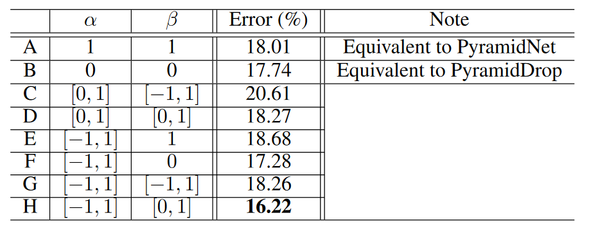
The setting that are used throughout the rest of the experiments are then [math]\displaystyle{ \alpha \in [-1,1] }[/math] and [math]\displaystyle{ \beta \in [0,1] }[/math]. Cases H and F outperform PyramidNet, suggesting that the strong perturbations imposed by ShakeDrop are functioning as intended. However, fully applying the perturbations in the backwards pass appears to destabilize the network, resulting in performance that is worse than standard PyramidNet.
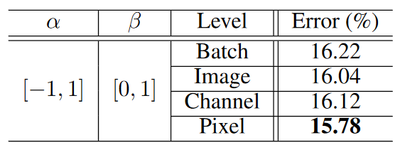
Following this initial parameter decision, the authors tested 4 different strategies for parameter update among "Batch" (same coefficients for all images in minibatch for each residual block), "Image" (same scaling coefficients for each image for each residual block), "Channel" (same scaling coefficients for each element for each residual block), and "Pixel" (same scaling coefficients for each element for each residual block). While Pixel was the best in terms of error rate, it is not very memory efficient, so Image was selected as it had the second best performance without the memory drawback.
Comparison with Regularization Methods
For these experiments, there are a few modifications that were made to assist with training. For ResNeXt, the EraseRelu formulation has each residual block ends in batch normalization. The Wide ResNet also is compared between vanilla with batch normalization and without. Batch normalization keeps the outputs of residual blocks in a certain range, as otherwise [math]\displaystyle{ \alpha }[/math] and [math]\displaystyle{ \beta }[/math] could cause perturbations that are too large, causing divergent learning. There is also a comparison of ResDrop/ShakeDrop Type A (where the regularization unit is inserted before the add unit for a residual branch) and after (where the regularization unit is inserted after the add unit for a residual branch).
These experiments are performed on the CIFAR-100 dataset.
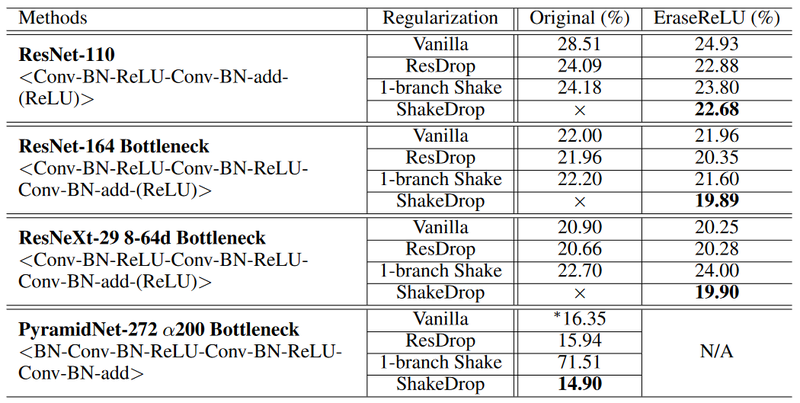

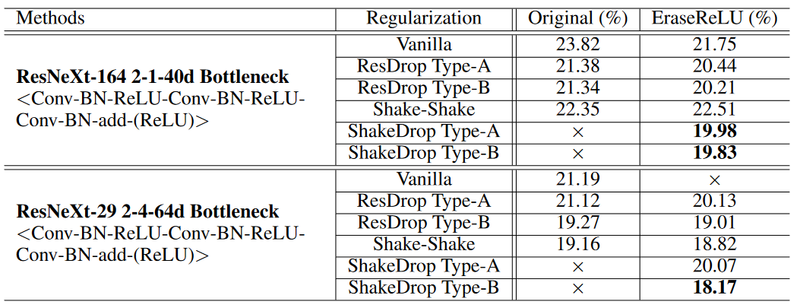
For a final round of testing, the training setup was modified to incorporate other techniques used in state of the art methods. For most of the tests, the learning rate for the 300 epoch version started at 0.1 and decayed by a factor of 0.1 1/2 & 3/4 of the way through training. The alternative was cosine annealing, based on the presentation by Loshchilov and Hutter in their paper SGDR: Stochastic Gradient Descent with Warm Restarts. This is indicated in the Cos column, with a check indicating cosine annealing.

The Reg column indicates the regularization method used, either none, ResDrop (RD), Shake-Shake (SS), or ShakeDrop (SD). Fianlly, the Fil Column determines the type of data augmentation used, either none, cutout (CO) (DeVries & Taylor, 2017b), or Random Erasing (RE) (Zhong et al., 2017).
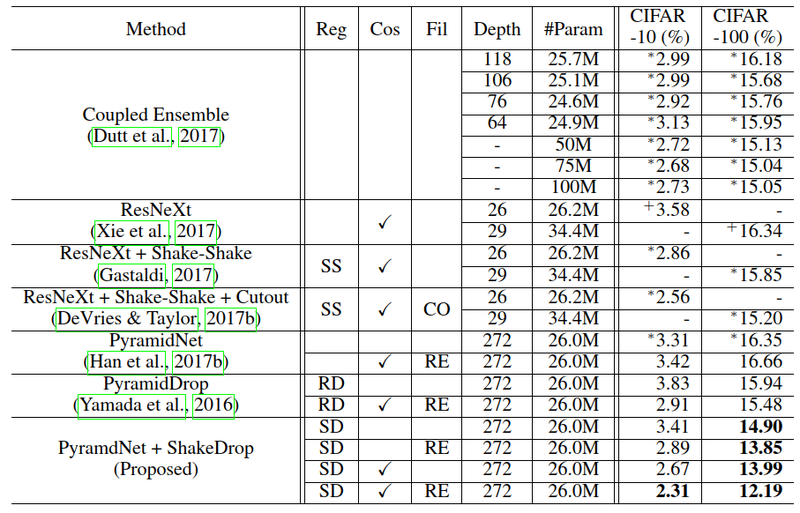
State-of-the-Art Comparisons
A direct comparison with state of the art methods is favorable for this new method.
- Fair comparison of ResNeXt + Shake-Shake with PyramidNet + ShakeDrop gives an improvement of 0.19% on CIFAR-10 and 1.86% on CIFAR-100. Under these conditions, the final error rate is then 2.67% for CIFAR-10 and 13.99% for CIFAR-100.
- Fair comparison of ResNeXt + Shake-Shake + Cutout with PyramidNet + ShakeDrop + Random Erasing gives an improvement of 0.25% on CIFAR-10 and 3.01% on CIFAR 100. Under these conditions, the final error rate is then 2.31% for CIFAR-10 and 12.19% for CIFAR-100.
- Comparison with the state-of-the-arts, PyramidNet + ShakeDrop gives an improvement of 0.25% on CIFAR-10 than ResNeXt + Shake-Shake + Cutout, PyramidNet + ShakeDrop gives an improvement of 2.85% on CIFAR-100 than Coupled Ensemble.
Conclusion
This paper proposed a new stochastic regularization method, ShakeDrop, which outperforms previous state of the art methods while maintaining similar memory efficiency. It demonstrates that heavily perturbing a network can help to overcome issues with overfitting. It is also an effective way to regularize residual networks for image classification. The method was tested by CIFAR-10/100 and Tiny ImageNet datasets and showed great performance.
Critique
The novelty of this paper is low as pointed out by the reviewers. The proposed ShakeDrop regularization is essentially a combination of the PyramidDrop and Shake-Shake regularization. The most surprising part is that the forward weight can be negative thus inverting the output of a convolution. The mathematical justification for ShakeDrop regularization is limited, relying on intuition and empirical evidence instead. As pointed out from the above, the method basically relies heavily on the intuition. This means that the performance of the algorithm can vary a lot depending on the characteristics of data sets that users are performing, with some exaggeration. However, the performance is still impressive since it performs better than known algorithms.
References
[Yamada et al., 2018] Yamada Y, Iwamura M, Kise K. ShakeDrop regularization. arXiv preprint arXiv:1802.02375. 2018 Feb 7.
[He et al., 2016] Kaiming He, Xiangyu Zhang, Shaoqing Ren, and Jian Sun. Deep residual learning for image recognition. In Proc. CVPR, 2016.
[Zagoruyko & Komodakis, 2016] Sergey Zagoruyko and Nikos Komodakis. Wide residual networks. In Proc. BMVC, 2016.
[Han et al., 2017] Dongyoon Han, Jiwhan Kim, and Junmo Kim. Deep pyramidal residual networks. In Proc. CVPR, 2017a.
[Xie et al., 2017] Saining Xie, Ross Girshick, Piotr Dollar, Zhuowen Tu, and Kaiming He. Aggregated residual transformations for deep neural networks. In Proc. CVPR, 2017.
[Huang et al., 2016] Gao Huang, Yu Sun, Zhuang Liu, Daniel Sedra, and Kilian Weinberger. Deep networks with stochastic depth. arXiv preprint arXiv:1603.09382v3, 2016.
[Gastaldi, 2017] Xavier Gastaldi. Shake-shake regularization. arXiv preprint arXiv:1705.07485v2, 2017.
[Loshilov & Hutter, 2016] Ilya Loshchilov and Frank Hutter. Sgdr: Stochastic gradient descent with warm restarts. arXiv preprint arXiv:1608.03983, 2016.
[DeVries & Taylor, 2017b] Terrance DeVries and Graham W. Taylor. Improved regularization of convolutional neural networks with cutout. arXiv preprint arXiv:1708.04552, 2017b.
[Zhong et al., 2017] Zhun Zhong, Liang Zheng, Guoliang Kang, Shaozi Li, and Yi Yang. Random erasing data augmentation. arXiv preprint arXiv:1708.04896, 2017.
[Dutt et al., 2017] Anuvabh Dutt, Denis Pellerin, and Georges Qunot. Coupled ensembles of neural networks. arXiv preprint 1709.06053v1, 2017.
[Veit et al., 2016] Andreas Veit, Michael J Wilber, and Serge Belongie. Residual networks behave like ensembles of relatively shallow networks. Advances in Neural Information Processing Systems 29, 2016.